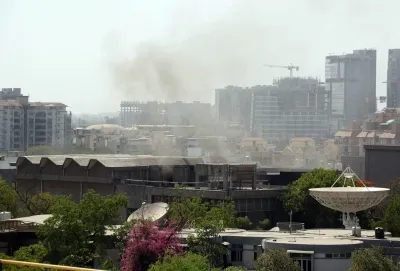What Caused the Fire at ISRO’s IT Server Building in Ahmedabad?

Synopsis
Key Takeaways
- Swift emergency response prevented casualties.
- Electrical short circuit likely caused the fire.
- Significant damage to IT infrastructure reported.
- Affected servers housed critical data.
- Similar incidents have occurred in the past.
Ahmedabad, Oct 23 (NationPress) A fire erupted at the IT server building within the Indian Space Research Organisation (ISRO) campus in Ahmedabad, prompting a rapid response from the city's fire services. The incident reportedly began on the upper floor of the structure located close to the outer gate of the ISRO site.
Four fire engines were dispatched to the scene, and firefighters successfully controlled the blaze in a timely manner. Thankfully, there were no reported casualties. Employees present in the building were evacuated safely as a precaution.
Initial investigations imply that an electrical short circuit might have triggered the fire, although the definitive cause is still under investigation. Authorities indicated that the flames inflicted considerable damage to the IT infrastructure, with numerous computers and equipment destroyed. The overall extent of the damage is currently being evaluated.
The affected servers are said to have housed critical data, leading to the initiation of an internal inquiry to ascertain the fire's cause and the extent of the loss.
A comparable incident occurred in 2018 at ISRO's Space Applications Centre (SAC) in Ahmedabad, where thick smoke was observed emerging from one of India's key space laboratories.
This previous fire, believed to be caused by a short circuit, erupted within a major facility of the centre, as reported by the city fire department at that time. A CISF guard was injured due to smoke inhalation, while firefighters managed to extinguish the fire.
During that event, the then SAC Director, Dr. Tapan Misra, confirmed that the antenna testing facility had caught fire, resulting in damage to specialized equipment.
ISRO has a significant presence in Ahmedabad through its Space Applications Centre (SAC), one of the organization's premier facilities.
Founded in 1972, SAC is crucial for developing payloads for communication, meteorology, remote sensing, and space science. Located in the Satellite area of Ahmedabad, SAC was established under the guidance of Dr. Vikram Sarabhai, the pioneer of India’s space programme, who envisioned the city as a centre for scientific and technological progress.
The centre plays a key role in designing satellite-based systems that bolster national initiatives in communication, disaster management, weather forecasting, and resource mapping. Over the years, the Ahmedabad unit has evolved into an essential conduit between space technology and societal applications, significantly contributing to India’s space achievements—from INSAT and IRS satellites to the latest advancements in navigation and planetary exploration.









